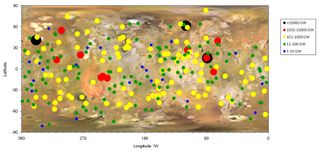Jupiter Moon Io's Volcanoes Revealed in New Map

A new map of Jupiter's oddly active moon Io has revealed the location of the moon's many erupting volcanoes, raising as many questions about the enigmatic satellite as it answers.
The map is the most comprehensive ever compiled of Io's hundreds of active volcanoes, researchers said. It also suggests a complex, multi-layer source for the moon's huge stores of internal thermal energy, which may come as a surprise to some astronomers.
"The fascinating thing about the distribution of the heat flow is that it is not in keeping with the current preferred model of tidal heating of Io at relatively shallow depths," co-author Ashley Davies, of NASA's Jet Propulsion Laboratory in Pasadena, Calif., said in a statement. "Instead, the main thermal emission occurs about 40 degrees eastward of its expected positions."

The heat is also coming from Io's depths along with its shallower reaches, researchers said.
Further, the study found that known active volcanoes account for only about 60 percent of Io's emitted heat. The source of the "missing" 40 percent is a mystery for now. [Gallery: Amazing Photos of Io]
"We are investigating the possibility that there are many smaller volcanoes that are hard, but not impossible, to detect," said study leader Glenn Veeder, of the Bear Fight Institute in Winthrop, Wash. "We are now puzzling over the observed pattern of heat flow."
Io, which is about 2,260 miles (3,640 kilometers) wide, was discovered by Galileo Galilei in 1610. It's the innermost of Jupiter's four largest moons and is tugged on hard by the huge planet, as well as its sister satellites Europa and Ganymede. These varied gravitational pulls cause massive flexing of Io's surface and interior, generating tremendous heat that is relieved via volcanism.
Get the Space.com Newsletter
Breaking space news, the latest updates on rocket launches, skywatching events and more!
That volcanism is frequent and intense, resulting in a surface unlike any other in the solar system. Most of Io's volcanic eruptions, for example, dwarf those we're familiar with here on Earth, and the Jovian moon is about 25 times more volcanically active than our own planet.
A better understanding of Io and its internal heating processes may shed light on the moon's sister satellites, researchers said. One of them is Europa, which is thought to have a huge liquid-water ocean under its icy shell. Many planetary scientists regard Europa as the solar system's best bet for harboring life beyond Earth.
The new study primarily analyzed data collected by NASA's Voyager and Galileo spacecraft but also looked at observations from several different telescopes on Earth, researchers said. It appears in the June issue of the journal Icarus.
Follow SPACE.com on Twitter @Spacedotcom . We're also on Facebookand Google+.
Join our Space Forums to keep talking space on the latest missions, night sky and more! And if you have a news tip, correction or comment, let us know at: community@space.com.

Space.com is the premier source of space exploration, innovation and astronomy news, chronicling (and celebrating) humanity's ongoing expansion across the final frontier. Originally founded in 1999, Space.com is, and always has been, the passion of writers and editors who are space fans and also trained journalists. Our current news team consists of Editor-in-Chief Tariq Malik; Editor Hanneke Weitering, Senior Space Writer Mike Wall; Senior Writer Meghan Bartels; Senior Writer Chelsea Gohd, Senior Writer Tereza Pultarova and Staff Writer Alexander Cox, focusing on e-commerce. Senior Producer Steve Spaleta oversees our space videos, with Diana Whitcroft as our Social Media Editor.
